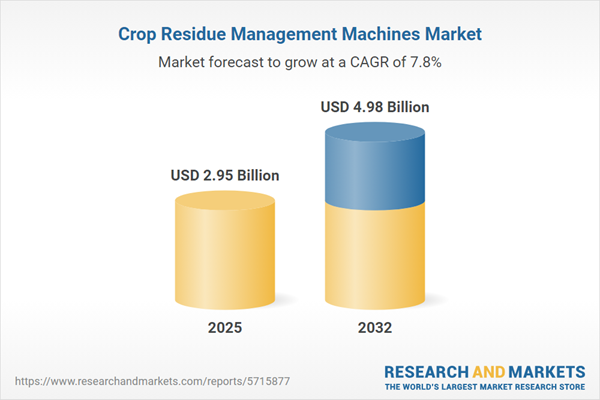Speak directly to the analyst to clarify any post sales queries you may have.
Crop residue management machines are at the forefront of sustainable agriculture, allowing enterprise-level farms to integrate environmental targets, compliance, and operational efficiency into their daily operations. Senior decision-makers are turning to these advanced machines as critical assets to address policy demands and operational challenges in the agricultural sector.
Market Snapshot: Crop Residue Management Machines Market
In 2024, the crop residue management machines market reached a value of USD 2.73 billion and is projected to rise to USD 2.95 billion by 2025, indicating a compound annual growth rate (CAGR) of 7.77%. This growth trajectory underscores how commercial farms are prioritizing resilient, sustainable equipment investments. High-performing machinery is enabling organizations to navigate evolving regulatory environments while meeting ambitious sustainability objectives and optimizing resource flows throughout their enterprises.
Scope & Segmentation in the Crop Residue Management Machines Market
Understanding how the market segments map to strategic goals is essential for informed leadership decisions. Segmentation empowers organizations to tailor procurement and deployment for maximum benefit:
- Type: Balers, incorporators, mulchers, rotavators, and shredders each serve distinct functions, enabling customization of residue processing based on crop volumes, field conditions, and operational expansion plans.
- Application: Equipment supports a broad array of settings, including broad-acre farms, specialty crop cultivation, managed lawns, orchards, and vineyards, elevating resource allocation and responsible land management for both intensive and niche operations.
- Mechanization Level: Choices span from manual and semi-automatic to fully automatic machines, allowing adaptation to operational scale, labor availability, and efficiency strategies.
- End Use: Solutions address bioenergy generation, composting, fodder improvement, and soil fertility management, reinforcing circular resource flows and long-term sustainability initiatives.
- Power Source: Diesel, electric, battery, hybrid, and PTO-driven options offer the flexibility to align investments with shifting energy trends, regulatory requirements, and environmental goals.
- Distribution Channel: Aftermarket dealers, direct OEM channels, and online marketplaces provide diverse procurement and support avenues, ensuring agile maintenance and streamlined equipment upgrades.
- Region: Distinct regional trends reflect variable rates of adoption and technology preferences across the Americas, Europe, Middle East & Africa, and Asia-Pacific. Regional factors such as policy incentives and local investment priorities often influence purchasing behavior and supplier relationships.
- Key Companies: John Deere & Company, CNH Industrial N.V., AGCO Corporation, Kubota Corporation, SDF S.p.A., Mahindra & Mahindra Limited, CLAAS KGaA mbH, Amazone GmbH & Co. KG, Pöttinger Maschinenbau Gesellschaft mbH, and Väderstad Holding AB are valued partners, known for broad solution portfolios and a continued focus on innovation to meet enterprise needs.
Key Takeaways for Senior Decision-Makers
- Integrating digital precision agriculture systems with crop residue management machinery offers greater operational transparency, easing compliance tracking and enhancing overall performance metrics.
- Access to diversified machinery in terms of mechanization and power options gives enterprises flexibility to adapt swiftly as workforce models, sustainability priorities, and compliance frameworks evolve.
- Automated machines help mitigate reliance on seasonal labor, establishing consistent residue handling while enabling reliable scaling across variable staffing scenarios.
- Strategic partnerships with manufacturers provide direct access to advanced technologies and technical support, easing integration of new processes and minimizing unexpected downtime.
- Aftermarket service investments and flexible upgrade pathways enable rapid response to regulatory or operational modifications without requiring wholesale equipment replacement.
- Utilizing robust digital platforms for fleet and maintenance management simplifies logistical oversight for distributed sites and drives higher equipment utilization rates.
Tariff Impact: 2025 Supply Chain Challenges and Strategic Responses
New U.S. tariffs on agricultural machinery components are bringing added complexity to the supply chain. Manufacturers are increasingly pursuing domestic sourcing and durable supplier partnerships to reduce exposure to global disruptions. Agricultural buyers, in turn, are prioritizing strong equipment service agreements and reliable upgrade strategies to safeguard against service interruptions and geopolitical uncertainty.
Methodology & Data Sources
This analysis is based on structured interviews with leading equipment manufacturers and enterprise-scale agricultural organizations. Supplementary intelligence is sourced from peer-reviewed literature, international trade data, and case studies focused on operational best practices, all filtered for executive applicability and market relevance.
Why This Crop Residue Management Machines Market Report Matters
- Supplies critical insights to support leadership in shaping procurement and sustainability policies aligned with industry and regulatory evolution.
- Delivers practical segmentation and technology perspectives, assisting executive teams in guiding investments, strategic partnerships, and operational deployment.
- Equips organizations to enhance business resilience and operational excellence in the face of shifting market conditions and changing external policies.
Conclusion
Advanced crop residue management machinery provides agricultural enterprises with the tools to strengthen operations and compliance while confidently addressing ongoing market and environmental challenges.
Additional Product Information:
- Purchase of this report includes 1 year online access with quarterly updates.
- This report can be updated on request. Please contact our Customer Experience team using the Ask a Question widget on our website.
Table of Contents
3. Executive Summary
4. Market Overview
7. Cumulative Impact of Artificial Intelligence 2025
Companies Mentioned
The companies profiled in this Crop Residue Management Machines market report include:- Deere & Company
- CNH Industrial N.V.
- AGCO Corporation
- Kubota Corporation
- SDF S.p.A.
- Mahindra & Mahindra Limited
- CLAAS KGaA mbH
- Amazone GmbH & Co. KG
- Pöttinger Maschinenbau Gesellschaft mbH
- Väderstad Holding AB
Table Information
| Report Attribute | Details |
|---|---|
| No. of Pages | 185 |
| Published | November 2025 |
| Forecast Period | 2025 - 2032 |
| Estimated Market Value ( USD | $ 2.95 Billion |
| Forecasted Market Value ( USD | $ 4.98 Billion |
| Compound Annual Growth Rate | 7.7% |
| Regions Covered | Global |
| No. of Companies Mentioned | 11 |









